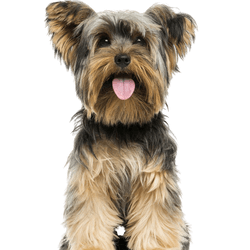Facts & Origin
Silkshire Terrier - The charming mix of Australian Silky Terrier and Yorkshire Terrier.
The Silkshire Terrier is a delightful hybrid dog created by crossing the Australian Silky Terrier with the Yorkshire Terrier. This unique blend combines the qualities of both breeds to create a playful and loving companion dog.
| Alternate Name | - |
| Origin | Australia - UK |
| Life expectancy | 12 - 16 years |
| Care requirements | high-maintenance |
| Activity level | average |
| FCI group | not recognised |
| AKC group | not recognised |
| KC group | not recognised |
More Australian Silky Terrier mixes
More Yorkshire Terrier mixes
Attitude, character and temperament of the breed
Possible character traits of the Silkshire Terrier.
The Silkshire Terrier often shows the following character traits, which are influenced by its parent breeds:
- Playful and Lively: He is a playful and lively dog that enjoys spending time with his family and is active.
- Affectionate: the Silkshire Terrier develops a strong bond with his owners and enjoys being around them.
- Intelligent: He is intelligent and open to training and new challenges.
- Alert: Because of his Terrier heritage, the Silkshire Terrier can be alert and warn his family of unwanted intruders.
The Silkshire Terrier is a lovable and entertaining mix that combines the best of both parent breeds. With the right care, attention and love, you will find in him a loyal companion who will delight you with his charm and personality.
Usage
Health and diseases
The Silkshire Terrier is generally a healthy dog, but it can have some health vulnerabilities. Here are some important health issues you should be aware of:
- Dental problems: Due to their small size, Silkshire Terriers are prone to dental problems such as tartar buildup and cavities. Regular dental care is important to maintain dental hygiene.
- Patellar luxation: this mix can be prone to patellar luxation, where the kneecap jumps out of its proper position. Regular veterinary exams can help detect and treat this problem early.
Care of the Silkshire Terrier
Grooming the Silkshire Terrier requires regular attention to maintain its coat and health. Here are some important grooming considerations:
- Coat care: brush the coat regularly to prevent matting and keep it healthy and shiny.
- Eye and Ear Care: Clean the eyes and ears regularly to prevent dirt and infection.
- Dental Care: Brush teeth regularly to prevent dental problems.
- Exercise: The Silkshire Terrier is an energetic dog that needs daily walks and active play to stay healthy both physically and mentally.
What does this mixed breed look like?
The Silkshire Terrier shows a mixture of traits inherited from its parent breeds. Here are some characteristic features you can expect in a Silkshire Terrier:
- Coat: It has a silky, smooth or slightly wavy coat that can come in a variety of colors such as black, brown or blue.
- Size: the size of the Silkshire Terrier is usually between 20 and 25 inches.
- Weight: He usually weighs between 3 and 6 kg.
| Fur length | long - medium |
| Fur | flat coated |
| Ear shape | Standing Ears |
| Tail | short |
| Anatomy | slim, slim |
| Size ♀ | 16 - 25 cm |
| Weight ♀ | 3 - 4 kg |
| Size ♂ | 16 - 26 cm |
| Weight ♂ | 3 - 5 kg |
| Suitable For | - |
Known Diseases
Cataract
Cataracts are still one of the most common causes of blindness, even in dogs.
Dermatophytosis
Dermatophytosis (synonym dermatophytosis, from ancient Greek τὸ δέρμα derma, German 'skin' and ancient Greek φυτόν phyton, German 'plant') or tinea (Latin for 'woodworm', 'moth') is a skin fungal disease caused by specific fungi (dermatophytes).
Ureteral ectopy
Ureteral ectopy (also known as ureteral ectopia) is an inherited condition where the ureter (known as the ureter) does not end in the bladder as usual due to a misalignment.
Patellar problems
Problems with the Patellar can be a displacement or weak kneecap, which is one of the most common causes of lameness in dogs, also because of overweight.
Dislocations
Lenticular and patella luxation occur in some breeds and affect the eye.
Bronchitis
Bronchitis in dogs is an inflammation of the lower airways in the area of the bronchi.
Eye infections
Chronic eye infections can be very painful in dogs and can be treated with medication. In rare cases, the cornea must be treated.
FAQ
-
On average, these mongrel dogs can grow between 25-35 cm tall.
-
These mixed breeds typically do not have excessive grooming needs as they have medium to short length coats.
-
They need a well-balanced, high-quality dog food that is specifically designed for their age, body size and activity level.
-
These mixed breeds are suspicious of strangers, but usually amiable and social with their family. Their behavior towards other pets depends greatly on the individual.
-
The life expectancy of this breed is usually 10-13 years.





















